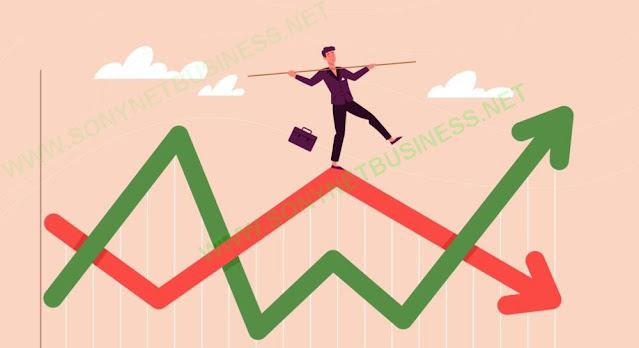 |
| What is volatility, exactly? |
Volatility, the fundamental property of asset prices, is critical for in-depth research of currencies, stocks, and futures. This comprehensive guide will explain what volatility is, how it is measured, and what factors influence it.
Definition & Description of Volatility
Traders use sophisticated computations to assess the reliability of their investments in order to reduce the risk of possible losses. Volatility is one of the measures they use to assess investment risks.
What is the definition of financial volatility? It is the price range in which the price swings over a brief period of time. Another definition of volatility is the difference between an asset's maximum and minimum value over a given period (sometimes, opening and closing price).
In most cases, the volatility indicator is expressed as a percentage. It can sometimes be seen in the price changes of the asset (points).
This indication resembles sea waves in appearance. During calm periods, the sea surface appears to be practically smooth. This is a low-volatility stock. However, when the market is engulfed by a storm, the waves continue to rise. As a result, there is a lot of volatility.
On stock and currency exchanges, as well as derivatives and commodities markets, price volatility is frequently used. This is one of the most crucial indicators that has a big impact on trading and investment methods.
Volatility comes in a variety of forms.
To begin, traders distinguish between low, medium, and high volatility levels:
Stock volatility of less than 20% is considered minimal. This reflects the market players' upbeat attitude. The further the indicator value deviates from this level, the more likely a trend reversal and movement in the other direction is. This is usually a hint that the investor should sell his or her securities and close his or her positions. When there is low volatility, it is critical to capture profits before the reverse begins.
The average amount of volatility is 20-30%. The fluctuation of the indicator readings inside this range is unable to provide any actionable alerts to the investor.
A market that is down 40% or more is showing signs of panic (or a volatile stock). This type of situation is frequently accompanied by a sharp drop in stock prices. This is a hint for the investor to look for a market entrance point. The share price will rise as the fever calms and the volatility value begins to decline. As a result, now is the optimum moment to buy stocks.
 |
| What is volatility, exactly? |
It's worth noting that these levels are primarily applicable to regular stocks and options. Because cryptocurrencies are equities with extreme volatility, daily changes of 20-40% are common.
There are two types of volatility that can be distinguished.
Volatility Implied
This financial tool aids traders in predicting an asset's future price. Future volatility tells the trader how likely he is to profit. Because the probability values are correct, he will get the exact theoretical value if he enters it into the option pricing algorithm.
The following factors influence the implied volatility factor:
- Historical volatility - the higher it is at the moment, the higher the forecasts for future market volatility may be.
- Situations in politics and the economy (elections, publication of economic indicators, etc.).
- Market liquidity (supply/demand) – prices fall when supply exceeds demand, and vice versa.
- Changes in technical levels – when an important price level is broken, the stock market is predicted to become more volatile.
- This is the day of the week.
Some services, similar to price prediction tools, estimate future stock volatility. Predictions are made for any time period, but most commonly for the remaining length of the contract (if we speak of options). Such a service can forecast volatility for the next 1, 2, or 3 months for a monthly baseline contract. Volatility forecasting, on the other hand, is still in its infancy, with few effective instruments available.
Volatility in the Real World vs. Volatility in the Past
This type of indicator depicts asset volatility over a defined period of time. For example, if an asset's prior volatility was not less than 10% and not more than 30% during the previous ten years, the price is very likely to remain in the range of 5-40% in the future.
How can you figure out historical volatility? There are numerous approaches, but the majority of them need the selection of two parameters: the previous period and the duration between successive price changes. At the trader's choice, the prior period can be 10 days, six months, five years, or any other length of time. Longer durations reveal ordinary volatility, but shorter intervals reveal unusual volatility variations.
What is the formula for calculating volatility?
The standard deviation of the underlying asset's daily returns over a specific period is used to calculate historical volatility in the options market. Because interest rates are always expressed in annualised terms, traders and analysts utilise an annual volatility index in practise.
The daily interest rate is calculated using the natural logarithm of the price ratio. Here's an illustration. The stock is currently trading at $100, with an intraday price of $102. For a single day, the simple interest rate is defined as:
2 percent = 102/100 — 1
The price is then reduced to $100. In simple percentages, prices will decline by:
–1.96 percent = 100/102
The drawback of this approach of calculating volatility is that percentage changes cannot be added together. The price change is 0 percent, not 2 percent, if the stock price starts at $100 and concludes at the same level — 1.96 percent = 0.04 percent.
The conventional volatility formula is also used by traders:
 |
| What is the formula for calculating volatility? |
To use this formula to calculate volatility, you must first:
- Determine the average.
- Determine the deviation (subtract the average from the actual price).
- The variance is calculated by squaring and adding all deviations.
- Take the square root of the variance to get the standard deviation.
What is causing this shift in volatility?
Market volatility is essentially a reflection of traders' emotions. The higher the swing, the more emotionally charged the crowd, and the more jittery trading decisions become.
When market participants continue to sell and buy due to their hesitancy (even major investors), asset prices can easily fluctuate by 10% or more per day.
Why does daily volatility wane sooner or later? People lose money and worry while the volatility continues, but once they run out of money and are tired of emotional swings, they take a break – trading is suspended.
What are the Influences on Volatility?
What causes market turbulence? Depending on the asset kind, there are a variety of possibilities.
The law of supply and demand
The ratio of supply and demand for an asset is the most important element driving stock market volatility. Volatility is often low if no unexpected market events occur and the scenario evolves as planned.
However, if the supply-demand equilibrium is disrupted, price changes will occur quickly. To demonstrate, consider the following scenario. When there is a scarcity of a particular asset, many traders desire to buy it. In this situation, the stock's value rises dramatically in a short period of time, resulting in a significant level of volatility.
Typically, supply and demand mismatches develop when the market receives unexpected news. A company's financial statement, for example, indicated a considerable decline in earnings. As a result, the value of this issuer's stock plummets dramatically.
Emotions
Investors demand financial disclosures, economic information, and interest rate choices from corporations and the government. Traders become concerned when reality differs from projections, and volatility rises.
Weather
Seasonal, or weather-related, factors have a significant impact on the prices of several agricultural commodities, such as corn, soybeans, and wheat. These characteristics are especially critical during the summer months, when drought can wipe out a large portion of the harvest, resulting in price swings and a bear market. As a result, grain price volatility is at an all-time high in June, July, and August.
On the other hand, it drops substantially in early spring, before the commencement of sowing in the United States and after harvesting in South America.
With this in mind, experienced traders advise allocating increased volatility to a summer option contract. If a trader decided in February that the May soybean contract's volatility would be 18 percent, he should assign a higher volatility to the November (next) contract — about 22 percent.
Seasonality
During the holidays, such as Christmas and New Year's, the market is typically significantly less volatile.
The exchange is "sleeping" at this time, with people enjoying their weekends and little interest in trading.
Examples of Volatility in the Real World
Open the Bitcoin chart to view how the price rate fluctuates over time to get a better idea of what high volatility stocks are. Although it shows stable long-term growth, its daily variations are rather substantial. For cryptocurrencies, a price movement of 10% to 40% in 24 hours is common.
Here's an example of volatility that shows how asset values are influenced by political events in January 2021. Gold futures began to rise following a report on US inflation and as investors awaited the outcome of a House vote on impeaching Donald Trump. Even platinum futures (a safe-haven asset) jumped 4%, breaking the trend of low volatility of less than 1%.
Examine the following examples of how global events cause volatility:
 |
| Examples of Volatility in the Real World |
Conclusion
Volatility is one of the most important features of assets and the market as a whole. It describes supply and demand while being influenced by a variety of circumstances. Traders should study this indicator if they wish to improve the efficiency of their tactics and predict price movements. To measure historical and implied volatility, there are a variety of instruments and algorithms available.














.png)
.png)